- Course Progress 15%
Chapter 2 – Word of Mouth Marketing
Facebook is the largest word-of-mouth marketing platform in the world, yet coaches, entrepreneurs, and small business owners aren’t using it that way. Most entrepreneurs and businesses are using Facebook, hoping to find customers with ads. The problem is that no one logs onto Facebook looking for our products and services. They log in to see what their friends are doing.
If, however, what their friends doing is registering for your next webinar, recommending your e-book, talking about how much they loved your last coaching visit or how well your product or service helped them with their problem, then, you can easily get “discovered” by thousands of real prospective customers on Facebook.
Facebook Is All About Sharing
Facebook is set up for sharing, and to encourage you to share, your content, which makes it easier for you and your business to get “discovered.” Facebook makes it easier than ever for your friends and fans to Like your content, your product, or your service. When anyone clicks the Like button for your page or content, that action goes on the person’s Timeline, which can be seen by their friends—which is how new prospective customers can find you on Facebook. And now, your content on your website can easily get shared through the Facebook Like Button, Share Counter, or Comment Stream, without leaving your website. This has incredible implications for your business because with all of this sharing, there’s a formula for growing your business. Don’t let the math scare you. It’s simple:
Traffic times Conversions times the Average Order Value
equals your Sales.
Are you wondering what this means for your business? Good question. Well, if you want to have more traffic to your website and more sales for your business, you need to pay attention and take action because Facebook can drive meaningful referral traffic to your website.
And why is that important? Remember the formula from above. With targeted traffic from Facebook, you can increase traffic, your conversion rate, or your average order value, and then, you will increase your sales.
Here’s the formula again:
Traffic × Conversion × Average Order Value = Sales
Driving Referral Traffic
Back in 2012, Facebook began to outpace Google as the #1 source of referral traffic driven to websites. In fact, Amazon’s traffic from Facebook went up 321{1f66b0d6ce0a11e4cd58ff5465420e8dd2d95871f419a96084a01d4981a25874} that year. This means that Amazon is getting more referral traffic from Facebook today than it does from Google. That’s huge!
It is now easier than ever for you, your business, and website to get “discovered” through friends who have “Liked” your page on Facebook. While people mostly used to find businesses through Google, today, more and more people find websites in new ways and are also interacting with brands in novel ways, ranging from commenting on photographs and others’ Facebook posts, to sharing their own ideas and posting their own images and videos on Facebook feeds.
Discovery Is the New Search
Recently, I was consulting with my client, good friend, and superstar coach to authors, Christine Kloser (www.fb.com/TransformationalAuthors), by helping her with a Facebook advertising technique I call “Social Proof Ads” for her Transformational Author Experience, for which over 28,000 people registered! She asked me to teach authors how to market their book on Facebook.

During the call, we received over 100 comments on the Transformational Author Facebook Page. As a result, thousands of people saw the post and “discovered” me. We had over 2,100 new people register with their e-mail addresses on my website for more information on our Facebook For Authors course (www.fbauthor.com).
One of our listeners, Dr. Fern Kazlow, sent me this message:

Dr. Fern Kazlow “discovered” me through word-of-mouth marketing on Facebook. She then signed up and paid to attend my live, two-day Attract Customers Now From Facebook Marketing Bootcamp. Here’s what she said about the bootcamp:
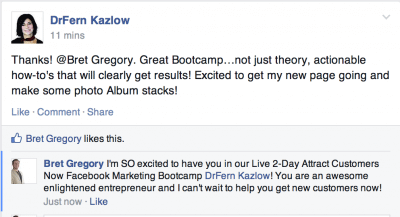
Word-Of-Mouth Marketing Online
Recently, I was doing a one-on-one laser-coaching session with my client and good friend, Sarah Ripard, on how we could grow her word-of mouth marketing for her television show Mom TV. At the end of our session, she thanked me profusely and told me how pleased she was with learning how to grow her following from Facebook with techniques like the Photo Album StackTM and the Article StackTM. To which I replied, “You’re welcome, hey, please don’t keep me a secret! Would you be willing to write a quick review of your results on my Facebook page?
Here is her review that she wrote on my page:
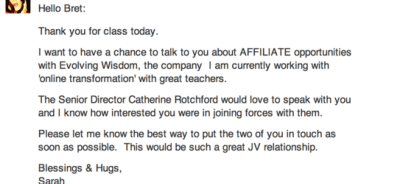
A few days later I got a friend request from Jodie Myers who “discovered” me through our mutual friend Sarah Ripard who then sent this message.

Jodie then went on to purchase my online course, Attract High-Paying Clients Now (www.AttractClientsNow.com), and her friends are now “discovering” my weekly free live class, where we teach our concepts to people who are developing new relationships through Facebook.
The 5 Most Powerful Words In Word-Of-Mouth Marketing
Now, for the most powerful 5 words I’ve ever heard in marketing. I learned this from Bill Cates, Author of a book called “Don’t Keep Me a Secret.” (I recently heard he learned it from my friend Joe Stumpf, Founder of By Referral Only, a multimillion dollar a year business coaching Real Estate Professionals how to get referrals through word of mouth marketing.)
Here are the 5 magic words: “Don’t keep me a secret.” Literally, just by saying “please don’t keep me a secret don’t keep me a secret ” to your happy clients (after you give them great value) and asking them to give you a one- or two-sentence review on your Facebook page, you can get “discovered” by hundreds of their friends and get new, qualified prospective customers to find you.
My good yogi friend and client, Julie Serot, attended one of my webinars and posted it on her personal profile. Ricardo Sierra, a Facebook friend of Julie’s, then “discovered” the webinar himself and signed up.
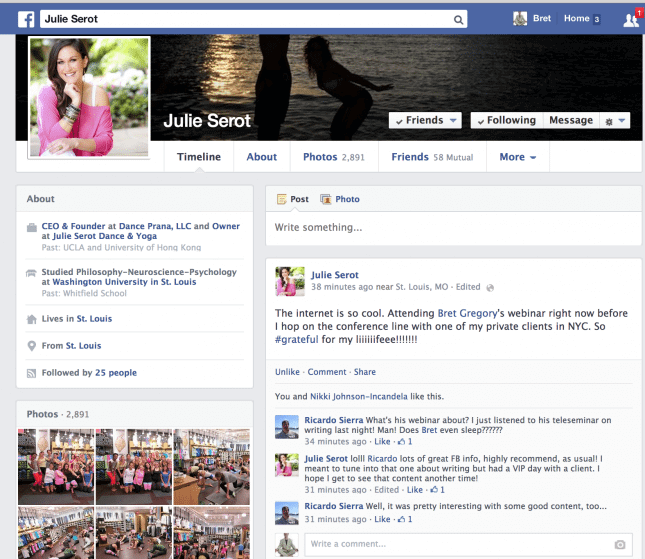
It really is as easy as asking your happy clients “please don’t keep me a secret” and to write a short testimonial on your Facebook page to leverage the largest word-of-mouth marketing platform in the world and get new clients to find you.
Post-Purchase Sharing
Recently, I visited Fiverr.com, an online freelance marketplace where people provide all kinds of services for $5. I love Fiverr, and if you haven’t used it, check it out. I needed a simple, custom Timeline cover designed for my Facebook page, so I typed in “Facebook Timeline cover design” in the Fiverr search bar, flipped through a few providers, and chose one that looked good. His or her Fiverr name is adin770. The providers aren’t allowed to use their real-life names or websites, so users can’t circumvent Fiverr, and that’s fine by me.
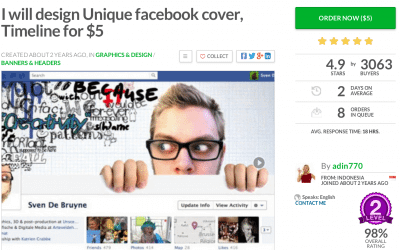
I got my Timeline cover back within 24 hours, and not only do I love it, but also, my page growth rate tripled with that professional cover alone! Paying $5 to go from 100 new Likes a day to 300 new Likes a day—talk about a positive return on investment (ROI)—that’s the best $5 I’ve ever invested in my business!

I was so pleased with my purchase (Fiverr calls them “gigs”) that I shared the results on my Facebook Timeline, using Fiverr’s post-purchase social plug-in Share button (see below). Several friends and fans immediately “discovered” this awesome service in their Facebook News Feeds, and they, too, hired Mr. (or Ms.) adin770. (www.fiverr.com/adin770/design-unique-facebook-cover-timeline)
You, too, can easily attract new customers now by adding a free Share plug-in from Facebook on your website. Using that, your happy customers can share you, your products, and your services with the click of a button. Just go to developers.facebook.com/docs/plugins/share-button, select “Get Code,” and have your developer put it on your website, next to your product or service offering.
Using Testimonials to Create Super-Customers
Your customers who are fans of your business Facebook page are super-customers. According to a white paper by social marketing and analytics firm Webtrends, which studied 11,000 Facebook ad campaigns in the United States, customers who were fans of a business’ Facebook page spend, on average, 135{1f66b0d6ce0a11e4cd58ff5465420e8dd2d95871f419a96084a01d4981a25874} more than non-fans. So, if you have a non-Facebook customer who spends $100, your Facebook customers might spend closer to $235 on your products or services because they’re already fans. These fans are known as “super-customers,” not only because they spend so much more, but also because they are far more likely to recommend your business to their friends. I’m going to show you how to get testimonials from them, and ultimately, referrals to new customers.
People buy socially and are influenced by the reviews of people who are like themselves. If your customers leave glowing reviews on your Facebook page, you’ll find that sales begin to pick up, as will the reputation of your brand and company.
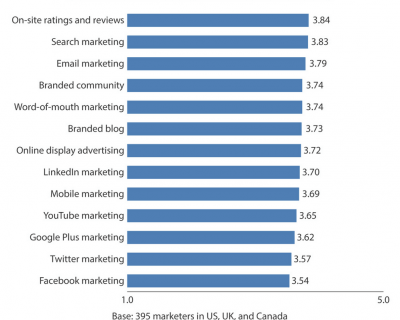
Getting testimonials from happy customers is like having a gold reserve for your business. Positive reviews can spread like wildfire, and nowadays, most customers will research reviews and opinions prior to purchasing.
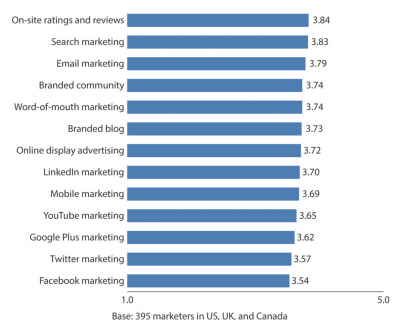
A recent survey of 395 corporations in the United States, United Kingdom, and Canada revealed that on-site ratings and reviews (i.e., customer testimonials) are the #1 highest return-on-investment marketing available today.
I got an e-mail from my good friend Mallika Chopra when she was trying to grow her Facebook page for her website www.intent.com. I replied back to her, saying I’d love to help her promote the page (www.facebook.com/intentdotcom) and help them get 10,000 new Likes. I asked up front if, after we got those fans and she was happy with the results, she would give me a testimonial for my course Attract Customers Now From FacebookTM (www.AttractCustomersNow.com/fan-reviews). She said yes and even gave a video testimonial too.
Then, she gave me an even better video testimonial for my YouTube channel. You can follow this link to see it: www.youtube.com/Vxr94o7shn0?t=1m50s.
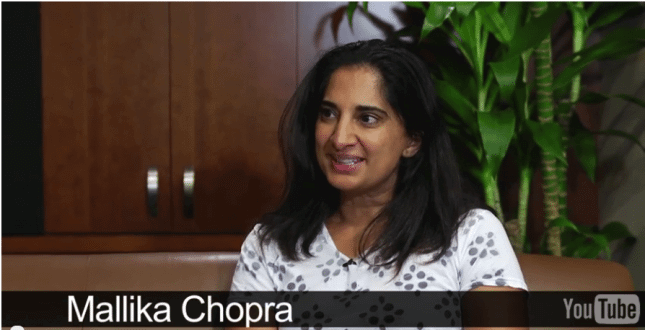
She then referred me to her close friend, super-successful enlightened entrepreneur Max Simon, with whom I was able to start working by helping him grow his tribe through his Facebook page: www.fb.com/bigvisionbusiness.
Studies prove that over 60{1f66b0d6ce0a11e4cd58ff5465420e8dd2d95871f419a96084a01d4981a25874} of people on Facebook have made a purchase of some kind through friend recommendations and testimonials, which means there must be a few new customers out there for you.
How to Get Great Testimonials
Let’s face it—people are really busy, and getting your customers, even incredibly happy customers, to write testimonials is tough. That’s why I use this simple three-step formula to get amazing testimonials every time.
Always deliver value first. Ask your customer up front if he will give you a testimonial, and be clear that this is conditional upon their happiness with you after you’ve provided your service. Always make sure they understand you won’t repeat your request for the testimonial unless they are sincerely happy. Then, make them happy! Deliver great service and value first, and wait until you hear the magic words “Thank you” or some other acknowledgement of your value.
Once they have acknowledged your value, say “Please don’t keep me a secret. Would you mind giving me a review on my Facebook page?” If you’ve given your customers a lot of value, they will likely say yes.
During that same conversation, go right into an extremely short interview and ask them the following three questions. Be sure to take notes. I like to use a Word document during the interview, so I can copy and paste their comments into a Facebook message or send them via e-mail to my customer. These are the questions I ask:
What problem were you struggling with before you discovered my business?
How has my business helped you specifically or what result did you achieve specifically, and in what time period?
What type of person would you recommend my products and services to?
Then, send them your notes via a Facebook message. (If you are not Facebook friends, the message will appear in their “Other” Facebook inbox. Direct them there if they cannot find it.) If they agree with the testimonial, ask them to copy and paste it to your business Facebook page or to the Facebook comments section on your website. Now you just got an amazing testimonial, and many of your customer’s Facebook friends may also see it.
If you want to see how we use testimonials to attract clients now, go to www.AttractCustomersNow.com/reviews.
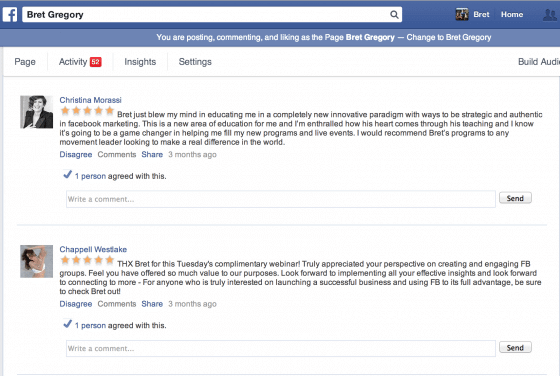
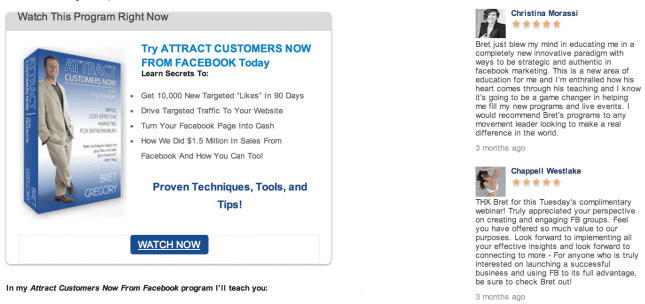
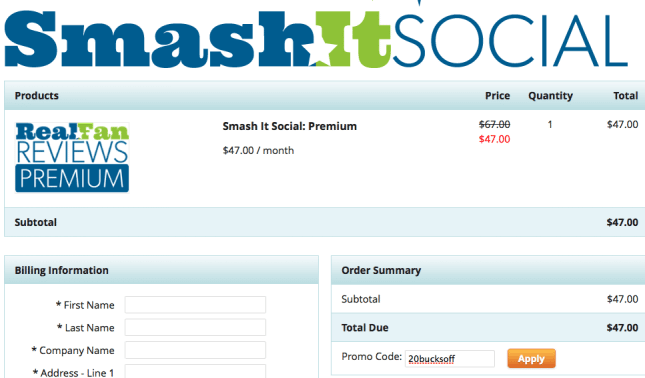
Get Your Amazon Reviews Shared On Facebook
If you have a book or a product on Amazon, you can use the same process above. While on a coaching call I recently got a great compliment from my consulting client, Helen, who read my book, and of course, I said, “Hey Helen, please don’t keep me a secret! Would you mind giving me that compliment on Amazon?”

Not only did she give me an amazing five-star review on Amazon, but also, she shared the review on her Facebook page (when I asked, ‘please don’t keep me a secret’) which helped me get “discovered” by her friends.
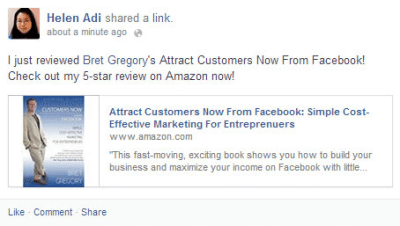
This is a perfect example of how word-of-mouth marketing can help new customers find you.
Personal Profile vs. Business Page

It’s important to know the differences between your personal profile and your business page.
A common question that many people have is, “Why do I need a Facebook page? Can’t I just use my own profile?”
A lot of people try to use their personal profiles on Facebook to market their business. Facebook allows you to have a personal profile, but if you want to promote your business, instead of using an individual profile, you need to use a fan page. Here is a direct quote from Facebook’s Terms of Service: “You will not use your personal Timeline for your own commercial gain (such as selling your status update to an advertiser).”
Also, from the Facebook Help Center: “Maintaining a personal account for anything other than an individual person is a violation of Facebook’s Statement of Rights and Responsibilities. If you don’t convert your noncompliant account to a Page, you risk permanently losing access to the account and all of its content.”
There are several other benefits to using a fan page:
Facebook limits the number of friends that you can have on a personal profile to no more than 5,000; however, fan pages have no limit.
You have access to incredible data on a fan page that you don’t on a personal profile, such as insights, impressions, and ratios, e.g., fans reached vs. page Likes, and number of people “talking about this.”
Facebook Tabs, access to advertising, and the ability to assign administrative roles.
Finally, using a personal profile to promote your business looks unprofessional.
You can “friend” a personal profile (i.e., add that person to your network), and you can have a maximum of 5,000 “friends.” (I’d love it if you would send me a Facebook friend request at www.fb.com/YogaBret.) You can Like a business page, and there is no limit to the number of people who can Like your page. Facebook wants you to use your personal profile for personal connections and a business page for your business. There are many good reasons to create a business page to promote your business, one being that is that it is a violation of Facebook’s Terms of Service for you to try and conduct business via your personal profile.
Creating a business page is simple. Go to www.facebook.com/pages and click the Create Page button in the upper right hand corner.
Then, select the type of business page you want to create.
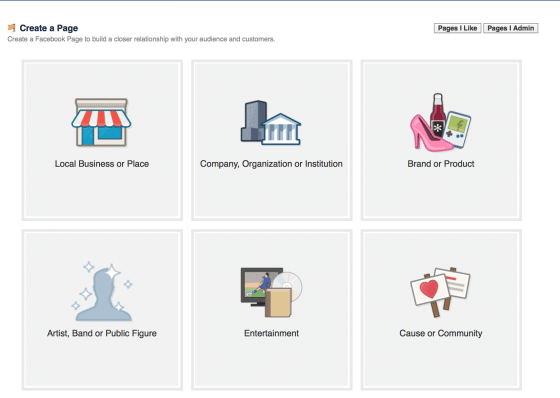

If you’re an author, speaker, or coach, you might want to select the “Artist, Band, or Public Figure” category. Also, I’m a fan of naming your page with your name if you are your business or brand.
Then, create a description, add your website URL, and choose your vanity Facebook URL (e.g., mine is www.fb.com/LikeBret). Keep in mind your page name is different from your vanity URL. There can be many pages with the same name, like Yoga, or Wellness, but there can only be one vanity URL. You can only choose the vanity URL once, and it cannot be changed. However, don’t worry if you can’t find the perfect URL, it makes little difference in the success of your page. I usually suggest adding the word “like” in front of your name (as I did with mine, www.fb.com/LikeBret) or the word “fan” or “fan page” after your name (such as www.fb.com/BretFan), if the other is not available.

Marketing, in a nutshell, requires understanding your customers better than they actually understand themselves. If you can articulate your customers’ problems better than they can, they will look to you (and will pay you well) for the solution.
Successful marketing is a step-by-step process, an activity that anyone can do. In order for marketing to be effective, it has to be ongoing. In other words, it’s not just an event.
In many ways, marketing involves finding a problem that your customer has and then building a solution. Many companies (that end up failing) make a product first and then try to find customers—and that’s backwards.
Don’t Build a Zune
In the late ‘90s, portable cassette and CD players were on their way out. There was a race to dominate the MP3-player industry, and the big competitors were Sony, with their Digital Walkman, and Microsoft, who produced the Zune. Apple wasn’t even expected to have a real chance at gaining any significant market share with their iPod.
The big mistake that Sony and Microsoft made is that they thought everyone wanted a better MP3 player, so they focused on building a product, and then, finding the customers for it. It turns out this is completely backwards from the way successful companies do it- it’s also one of the biggest mistakes entrepreneurs make. While this is quite counterintuitive, successful companies find the customers first; then, they build a product for them. Said another way, you find a problem that a large group of people has, come up with a solution, and you have a built-in customer base. That means, you’re in the business of solving problems!
Sony and Microsoft were wrong. You see, people couldn’t care less about an MP3 player. Because Sony and Microsoft completely missed the customers’ real needs, their products flopped. Apple started with the customer. Sony and Microsoft started with the product.
Before they invented the iPod and the iPhone, Apple kept hearing their customers saying, “I really wish I could just buy the one song that I love off of a CD album. I hate having to buy the whole album for $12.99 when all I want is one song, which should be only $.99. If I could do that, then I would buy all my favorite songs—and I want that all in my pocket.”
Well, Apple found the customers first and then built the solution for them. They first went to the record labels and negotiated a deal to sell just one song at a time to their customers, then built the iTunes platform and made buying songs one-click simple. Finally, they built the iPod MP3 player and came out with it in 2001. Apple solved the real problem that the customers had—paying $12.99 for only one song they actually wanted—and that’s what made them one of the world’s most valuable companies.
Apple’s slogan for selling the iPod in 2001 was “1,000 songs in your pocket.” However, customers got what they really wanted – 1,000 of their favorite songs in their pocket. That was the real solution that won the race for market share.
Most of Your Marketing Won’t Work
Marketing involves motivating your customers to take action. You will need a call to action to inspire your customers. You will also have to talk with your customers to understand their needs.
There is a dirty little secret in marketing: most of your marketing won’t work. The companies that are the best at marketing out there understand this. They understand that they’ve got to try new things out, and they’ve got to test. Again, the best marketers understand if some of their marketing isn’t failing, then they’re not doing enough marketing.
A good rule-of-thumb I’ve found is that I have to try 10 versions of marketing activities to get one success. So when I create an ad on Facebook, I don’t create one ad. I create 10 versions of the ad and test to find the best one. I may create 1 ad and advertise it to 10 different audiences to find the most profitable target audience. That is a formula that consistently creates profitable results. The good news: Facebook has made it incredibly easy to create multiple versions of one ad. You can upload six different photos at once when you create your ad, and they also give you an option to duplicate your ad with one click of the “Create Similar Ad” button.
Facebook marketing, and all of your marketing, in fact, is also tied to what is called “social proof.”

